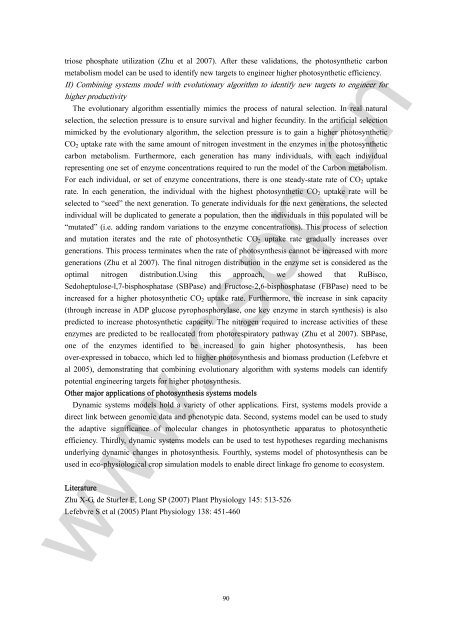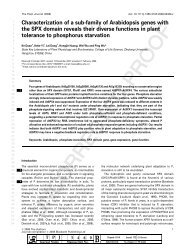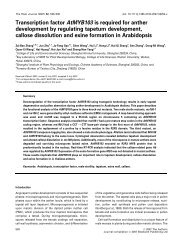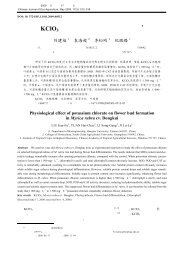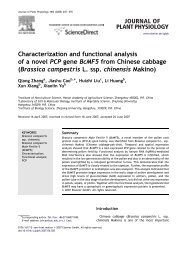Untitled - ä¸å½æ¤ç©ççä¸ååçç©å¦å¦ä¼
Untitled - ä¸å½æ¤ç©ççä¸ååçç©å¦å¦ä¼
Untitled - ä¸å½æ¤ç©ççä¸ååçç©å¦å¦ä¼
Create successful ePaper yourself
Turn your PDF publications into a flip-book with our unique Google optimized e-Paper software.
triose phosphate utilization (Zhu et al 2007). After these validations, the photosynthetic carbon<br />
metabolism model can be used to identify new targets to engineer higher photosynthetic efficiency.<br />
II) Combining systems model with evolutionary algorithm to identify new targets to engineer for<br />
higher productivity<br />
The evolutionary algorithm essentially mimics the process of natural selection. In real natural<br />
selection, the selection pressure is to ensure survival and higher fecundity. In the artificial selection<br />
mimicked by the evolutionary algorithm, the selection pressure is to gain a higher photosynthetic<br />
CO 2 uptake rate with the same amount of nitrogen investment in the enzymes in the photosynthetic<br />
carbon metabolism. Furthermore, each generation has many individuals, with each individual<br />
representing one set of enzyme concentrations required to run the model of the Carbon metabolism.<br />
For each individual, or set of enzyme concentrations, there is one steady-state rate of CO 2 uptake<br />
rate. In each generation, the individual with the highest photosynthetic CO 2 uptake rate will be<br />
selected to “seed” the next generation. To generate individuals for the next generations, the selected<br />
individual will be duplicated to generate a population, then the individuals in this populated will be<br />
“mutated” (i.e. adding random variations to the enzyme concentrations). This process of selection<br />
and mutation iterates and the rate of photosynthetic CO 2 uptake rate gradually increases over<br />
generations. This process terminates when the rate of photosynthesis cannot be increased with more<br />
generations (Zhu et al 2007). The final nitrogen distribution in the enzyme set is considered as the<br />
optimal nitrogen distribution.Using this approach, we showed that RuBisco,<br />
Sedoheptulose-l,7-bisphosphatase (SBPase) and Fructose-2,6-bisphosphatase (FBPase) need to be<br />
increased for a higher photosynthetic CO 2 uptake rate. Furthermore, the increase in sink capacity<br />
(through increase in ADP glucose pyrophosphorylase, one key enzyme in starch synthesis) is also<br />
predicted to increase photosynthetic capacity. The nitrogen required to increase activities of these<br />
enzymes are predicted to be reallocated from photorespiratory pathway (Zhu et al 2007). SBPase,<br />
one of the enzymes identified to be increased to gain higher photosynthesis, has been<br />
over-expressed in tobacco, which led to higher photosynthesis and biomass production (Lefebvre et<br />
al 2005), demonstrating that combining evolutionary algorithm with systems models can identify<br />
potential engineering targets for higher photosynthesis.<br />
Other major applications of photosynthesis systems models<br />
Dynamic systems models hold a variety of other applications. First, systems models provide a<br />
direct link between genomic data and phenotypic data. Second, systems model can be used to study<br />
the adaptive significance of molecular changes in photosynthetic apparatus to photosynthetic<br />
efficiency. Thirdly, dynamic systems models can be used to test hypotheses regarding mechanisms<br />
underlying dynamic changes in photosynthesis. Fourthly, systems model of photosynthesis can be<br />
used in eco-physiological crop simulation models to enable direct linkage fro genome to ecosystem.<br />
Literature<br />
Zhu X-G, de Sturler E, Long SP (2007) Plant Physiology 145: 513-526<br />
Lefebvre S et al (2005) Plant Physiology 138: 451-460<br />
www.cspp.cn<br />
90


